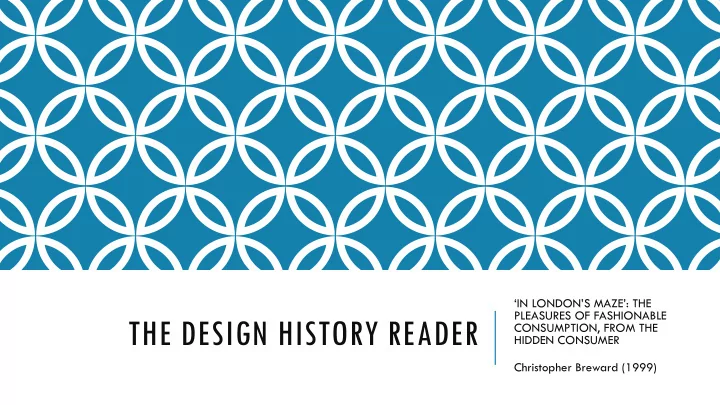

‘IN LONDON’S MAZE’: THE PLEASURES OF FASHIONABLE THE DESIGN HISTORY READER CONSUMPTION, FROM THE HIDDEN CONSUMER Christopher Breward (1999)
THE PLAYGROUND OF THE CITY LIFE: CLOTHING AND THE CONVIVIALITY OF BACHELORDOM In the piece it talks about a man (‘a master’) with an assistant who helps the man dress. He has full control of his masters attire. Upper Class- It is suggested that he is the 'finished product of civilisation' because he is‘ He is booted, hatted and gloved’. ‘Cigarette case is made from enameled gold with an S inlaid in diamonds.’ ‘ Hand picks his flower for his button hole’. The piece highlights his countless selection of canes, cravates and pins in which only the uper class could afford. Lynn Hapgood reiterates this by suggesting that' the upper class in particular is portrayed as all surface since its concerns are with life as art, in a deliberate evasion of reality.' There is a debate of masculinity as the men take care of their appearance. ‘ the problems city life gave to understanding male desire C.1880 + 1914’ Popular novels, tourist guides, journalistic accounts and adverts – both real and imaginary gave an ideal dandy (A man who places particular importance upon his physical appearance) Senton (Master from the piece) was seen as a perfect example of masculinity and greediness pf acquiring money or material things
Richard Dellamora writes about how male politicians have been blind the significance of homosexual scandal in 1890’s. He sees other historians as trying to protect the masculinity at the time. Dellamora repositions the dandy (male) to be at the centre of interactions. He ignores the day to day commercial significance of his type. ‘The dandy (male) consumes to excess while producing little or nothing’ The perception of Oscar Wilde is discussed and the influence that his 1895 Scandal had on masculinity in the twentieth century attitudes towards manliness. Regenia Gagnier states that Oscar Wilde made a choice for the non- working class men to appear as a gentlemen, the manner of which had been perfected by the dandy (male). Wilde also mocked ideas of gentlemanliness with disastrous results. Sentons (male from piece) description describes a reflection of what London shops and catalogues offered ambitious young men.
If a male dressed well like a dandy they represent and adhere to a smart society in an expanded area if consumer choices. London and Londoners (published 1898) explains the above point where the author provides a tongue- in – cheek guidance to modern society. It pointed out the familiar knowledge that defined the powerful status of a fashionable bachelor. The figure of a 'leisured bachelor' began to symbolise a modern and fashionable position by the 1890's. 1860’s began a celebration of the romantic, irresponsible lifestyle associated with the single man. This reached its highest point in 1900. Bachelor Characteristics drew influences from political persuasion to physical appearance to interior decoration. This was the climax of a man who lived a luxurious sociable lifestyle and spent his day ‘ researching articles’ for popular press in the comfort of a west end restaurant/café.
Popular journals described the bachelor dandy in an emotional strain of the ideal. There were descriptions of their behaviour in the streets and bars and also their appearance. For every clean-cut Englishman there was a more derogatory model supporting the ‘wicked’ attractions of the ‘east end’. There was a tendency to consider them to be the same as certain forms of physical appearance and betrayal of the ideal gentleman appearance had prejudice(pre conceived opinion) implications. Inversions of fashionable masulinity such as a 'Bohemian artist'(an artist who secedes from conventiality)who had a laboured manipulation of appearances became a potential rival to the bachelor.
WE THREE TRODDLES 1902 (NOVEL COVER) Showed more negatives interpretations of a bachelor. Presented problematic – expressed modern attitudes to city life.
There were contradictory tensions between commercial cultures and artistic originality in the bohemians. Threats to the mannered perfection pf the bachelor and his limits of his make-up and environment. There were possibilities in a wider urban culture of the commercial boundaries set up to describe a bachelors position as ‘west end sophistication’. ‘In the west Pleasure is Business and in the east its an activity done for enjoyment’ Bachelor Figure has a close association to a fashions consumer culture. The Dapper persona of a bachelor drew accusations of being not genuine. This was from observations tied to the feminised and weary concerns of the west- end. East end offered masculine pleasure, free from business and an arena in which the bachelor identifies matched dangerous connotations and mediation.
Recommend
More recommend